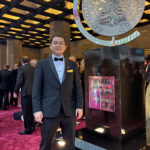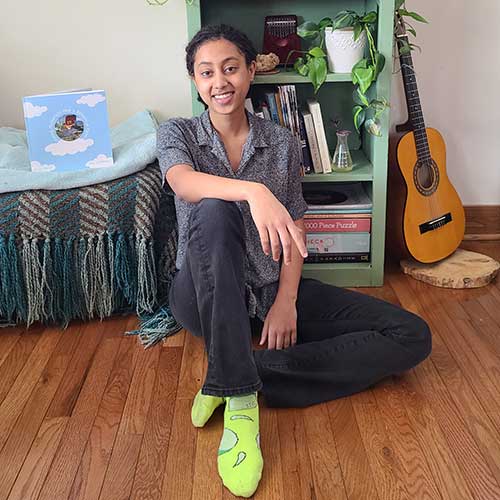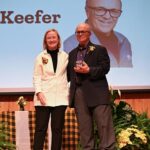
Wooster alumna publishes AI-art children’s book with a new plant-based take on classic Old MacDonald rhymes

In February, Wooster alumna Alayt Ablam ’21 and current predoctoral fellow at The Grainger College of Engineering at The University of Illinois Urbana-Champaign, along with her advisor and co-author Lav Varshney, published an artificial intelligence-illustrated children’s book, Young McDonald Had a Botanical Farm. The book is a new take on the classic rhymes of “Old MacDonald.” In the place of an animal, each verse is reimagined with a fruit or vegetable.
Ablam, a mathematics major and studio art minor, said the inspiration for this AI-illustrated children’s book came one night as Varshney, an associate professor in electrical and computer engineering at U of I, was reading a bedtime story to his children. The subject of the book was conceived in a research meeting about plant communication. “Varshney was inspired to write poetry that resonated with the conversations we were there to decipher,” said Ablam. “He then sent me the poetry, and I made the art inspired by the verses on the poem.”
In order to create the AI art featured in the book, Ablam used a VQGAN+CLIP architecture. VQGAN, a “vector quantized generative adversarial network,” can generate new images when given existing input, and CLIP, or “Contrastive Image-Language Pretraining,” which is a neural network trained on a variety of image and text pairs, helps VQGAN understand the images that it’s trying to create. “VQGAN generates iteratively, and CLIP guides the images via the prompts so the images are more in line with what you want,” Ablam explains. For each image, Ablam edited the prompt to match her desired output, and then ran the program a thousand times and picked her favorite of the images. This process is a part of an emerging field of tech known as human-AI interaction. “AI is a tool, and you are the artist,” Ablam explains, “both verbally (the way you write the prompt) and visually (the image you pick).”
Ablam’s interest in AI began with her senior I.S. project, which asked what it means to understand a concept in a visual format. She sourced knowledge from semantic vectors that hold the understanding of words people use in everyday language and incorporated them into an algorithm known as Generative Adversarial Networks to generate visually indeterminate images for concepts that are obscure to imagine. This process questioned the creativity of the machine, and it was while doing the literature review for her I.S. that Ablam encountered two papers by Varshney. “I was utterly captivated,” she said, “so I reached out, and here I am.”
Young McDonald Had a Botanical Farm was released in February 2022, and the proceeds of book sales will be donated to nonprofit organizations in Ablam’s home country of Ethiopia. Initial proceeds will go to SOS, a global health non-profit, for humanitarian work in Tigray, while others will promote agricultural research through the Bethel Agricultural Association, “both of which are within the essence of the book,” Ablam says.
Posted in Alumni on May 24, 2022.
Related Posts
Related Areas of Study
Art - Studio Art
Studio space, small classes with talented instructors, and the strong foundation that comes with a liberal arts education.
Major MinorMathematics
Numbers + patterns + structures multiplied by a zest for analysis and inquiry
Major MinorComputer Science
Solve complex problems with creative solutions using computer programming and applications
Major Minor

